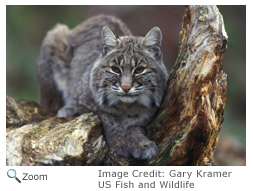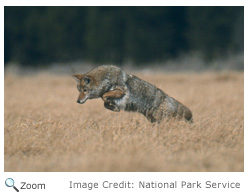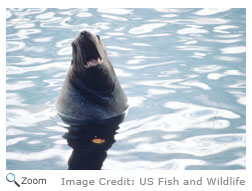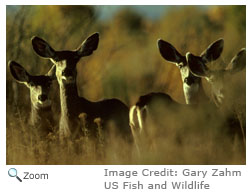Adapted for Meat
 Carnivores are predators. They hunt and eat other animals to survive. Mammals that are carnivores have sharp teeth adapted for ripping meat from a carcass. Carnivores are predators. They hunt and eat other animals to survive. Mammals that are carnivores have sharp teeth adapted for ripping meat from a carcass.
Carnivores, like the wolf, have large, powerful jaws that help bring down large animals like white-tailed deer. The bobcat and mountain lion have powerful paws with sharp claws that help them catch prey.
For the Birds
 Meat-eating birds, like hawks and owls, have keen eyesight that makes it easier for them to spot prey. They have sharp talons to catch prey and curved beaks to tear up meat. All of these adaptations help carnivorous birds catch and eat their prey. Meat-eating birds, like hawks and owls, have keen eyesight that makes it easier for them to spot prey. They have sharp talons to catch prey and curved beaks to tear up meat. All of these adaptations help carnivorous birds catch and eat their prey.
Hard Work
 Carnivores have to work hard for their food. Most prey animals have good defense systems to help them avoid predators. Most warm-blooded predators like the coyote have to hunt frequently. Cold-blooded predators like snakes can go days or even months between meals. Carnivores have to work hard for their food. Most prey animals have good defense systems to help them avoid predators. Most warm-blooded predators like the coyote have to hunt frequently. Cold-blooded predators like snakes can go days or even months between meals. |
|
Hunting in the Water
 Some carnivores, like the seal and the sea lion, spend a lot of time hunting in the water. Sea lions, walruses, and seals are pinnipeds, which means "fin feet." Pinnipeds are adapted for hunting in the water. They have torpedo-like bodies that help them shoot through the water, flippers for legs, and some have ears and noses that close up when they are underwater. Pinnipeds eat fish, crabs, and other marine animals. Some carnivores, like the seal and the sea lion, spend a lot of time hunting in the water. Sea lions, walruses, and seals are pinnipeds, which means "fin feet." Pinnipeds are adapted for hunting in the water. They have torpedo-like bodies that help them shoot through the water, flippers for legs, and some have ears and noses that close up when they are underwater. Pinnipeds eat fish, crabs, and other marine animals.
Keeping It All in Balance
 The carnivore's niche in the community is to help control populations. Very young, old, or sick prey are most vulnerable to predators. Without predators populations of animals like mice and deer would grow too large, and sick animals might spread disease to other animals. By catching prey, carnivores help keep a balance in communities between producers and consumers. The carnivore's niche in the community is to help control populations. Very young, old, or sick prey are most vulnerable to predators. Without predators populations of animals like mice and deer would grow too large, and sick animals might spread disease to other animals. By catching prey, carnivores help keep a balance in communities between producers and consumers.
|